2010 Yamaha Nytro RTX SE Review
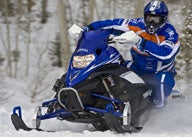
Yamaha brings trick features and strong power from snocross to the trail
No one disputes the quality of Yamaha snowmobiles. They run like major appliances, because Yamaha snowmobiles undergo some of the most thorough pre-introduction testing we’ve ever seen.
Due to the company’s high standards, Yamaha claims its sleds are Number One in six distinct categories: reliability, fuel economy, low emissions, low cost of operation, ease of operation and resale value. That’s quite a statement from a company designs its sleds foremost to meet the core needs of its customers: performance, handling and comfort. With Yamaha’s success in introducing its 4-stroke snowmobiles to the market, you can’t fault the company’s direction, which appears to be headed consistently upward.
Engine Type:Horizontal In-line
Cylinders:3
Engine Stroke:4-Stroke
Valve Configuration:DOHC
Displacement:1049 / 64
Starter:Electric
Turbocharged:No
View Full SpecWhile we find Yamaha snowmobiles of a high and admirable quality with excellent engineering, we can still find some things that fail to inspire us. For example, we find the fuel injected Vector an absolute delight. We enjoy the four-cylinder Apex. But, honestly, we get mixed messages from the Nytro series. It definitely grabs our attention, but we have yet to fully appreciate its handling and power characteristics, which we feel go hand in hand.
Yamaha PowerThe 2010 Nytro RTX SE comes with a three-cylinder engine bred specifically for snowmobiling. It has the right pedigree with a highly sophisticated electronic fuel injection system that consists of computerized data readings to control the action and response of fuel fed through three 41mm Mikuni intakes. Controlled by a computerized brain this fuel injection system adds the sophistication of an intake heated via the engine’s cooling system. The electronic programming of the performance triple reads everything that matters in performance from throttle openings, barometric pressure, ambient temperature and even fuel quality. It does all this in split second increments. That’s why when you engage the throttle the reaction is virtually instantaneous. And very impressive.
The Nytro triple delivers a solid 130-horsepower that spools quickly and gets to the track in a big hurry. But, then you’d expect that from a motor that derived much of its developmental testing from the snocross track. It reacts quickly via a Yamaha engineered and race-bred YVXC clutch system.
Measuring 1049cc in overall displacement, the Yamaha Genesis 130FI triple already claims some impressive straight-line acceleration wins. Its performance is conducive to quick holeshots and hard acceleration. But we’ve found this action makes the Nytro RTX SE a bit difficult to manage on the trail. It is definitely strong, but when the skis lift, you have little bite for grabbing a corner’s apex for a quick exit. Yes, there is a learning curve to any sled, but we find the Nytro RTX SE requires more of a learning curve than we’ve been able to invest.
Race BreedingLet’s not denigrate the motor, which performs exactly as intended. It is a marvelous 4-stroke. Sophisticated, powerful, full of revs and torque. We think there is more going on here than simply motor. In many ways, the Nytro RTX reminds us of the Phazer, which we’ve tried many times to love, but come away jilted. We think that the Nytro RTX SE is too much racetrack and too little trail. Fortunately the RTX SE version is intended for the high performance rider. Unfortunately, that rider looks at weight as well as horsepower and may find that 130 horses pulling nearly 530 pounds of sled may not be a good thing. Actually, we’ve noticed that Yamaha no longer publishes its dry weights, but last year’s similar RTX SE was said to weigh in around 530 pounds. Guess you can deduce that Yamaha recognizes that performance riders look at weight figures, too.
Now, in the interest of full disclosure, we readily admit that one of our test riders seriously crunched the only 2010 Yamaha Nytro RTX SE pre-production test sled at this year’s new model introduction in Colorado. To Yamaha’s credit, the field staff made suitable repairs to the damage, but our impressions of the sled do not rest with that incident, which was caused by ice and speed. Not sled geometrics.
Translate To TrailStill, we have begun to think that just because a sled makes a manufacturer’s race team happy, it doesn’t automatically translate to the serious trail rider. This isn’t simply a Yamaha issue. We see it in other brands as well. Just because a sled works well on a snocross track does not guarantee its suitability for trail performance. We would be more impressed if sleds were developed from cross-country competition than snocross. Cross country sleds have to respond to the same conditions as a trail sled as the riders run from icy lakes, over rutted out ditches and down county roads. Snocross may be exciting to watch, but in most cases the quick acceleration, high-flying, heaving pounding a snocross sled takes is not typical of an everyday trail performance sled.
We feel that Yamaha engineering took too much from its snocross efforts and put it into the everyday Nytro. The good news is that the aluminum chassis and new FXG2 front suspension are very positive takeaways from that form of racing. As readers of these reviews may recognize, we are not big fans of Yamaha’s rear suspensions, although the Dual Shock Pro 46 is growing on us. You get up to 14.5-inches of travel controlled by “clicker” adjustable shocks. The rear arm shock is an impressive one. It comes with a 3-way clicker to tune high and low speed compression as well as allowing tuning of the rebound rate on this 46mm design.
Fox Float XThe front suspension shocks are Fox FLOAT that can run high air pressure in the main chamber to control roll and feature a remote reservoir for cooling that limits fading. These Float “X” shocks resulted from a Yamaha and Fox collaboration to create shocks that resist fade but can be tuned via compression and rebound clickers. We have to say, mission accomplished with this package.
Other aspects brought over from the race team includes moving the steering post over the engine. Yamaha claims that this gives the rider improved “posture” on the sled. That would be racer posture we guess. This design brings the engine deeper into the chassis. Here again is where we disagree with Yamaha design. No, we are not design experts, but it seems to us that trail riding the sled we get a feeling that the Nytro RTX SE is too biased to the center at the expense of front end handling and weight distribution. There must be a compromise between too much weight over the skis — can we say Apex? — and too little weight over the skis — can we say Phazer? That’s our feeling based on many years of riding all kinds of sleds — good bad and truly dreadful!
The Nytro RTX SE is quite good overall with a potent motor. And its quality is unassailable. We think Yamaha has really honed in with its ergonomics. There is a nicely sculpted seat that suits action riders extremely well. That’s a good thing brought over from snocrossing. The aluminum chassis is well designed and the runningboard punchouts grip your boots well. This Nytro is definitely a standout from a style viewpoint.
FutureWe are very interested in what Yamaha has planned for us in the years ahead. This company builds extremely good snowmobiles with 4-stroke engines that have redefined snowmobile performance at every level — speed, power, economy, reliability, ease of maintenance and so on. We may disagree with Yamaha engineering in some areas, but we will never dispute this company’s commitment to us snowmobilers for the future. Let’s just say, that while we recognize the 2010 Nytro RTX SE as a solid performer for the roughest trails, we think this limited edition model is suited to the most aggressive rider who is more racer than long distance rider.
Yamaha Nytro RTX SE Specifications
| 2010 Yamaha Nytro RTX SE Specs | |
| Engine | Yamaha Genesis 130FI; liquid-cooled, 1049cc 4-stroke triple; Mikuni 41mm fuel injection |
| Horsepower | 130 |
| Drive | Yamaha YVXC variable ratio drive and driven |
| Front Suspension | Yamaha double wishbone FXG2; 8.5-inches maximum travel; Fox Float X dual-clicker shocks |
| Rear Suspension | Yamaha Dual Shock Pro 46; 14.5-inches maximum travel; C40 dual clicker gas shock on front arm; C46 3-clicker gas shock on rear arm |
| Length | 110.4 in |
| Width | 46.4 in |
| Height | 44.8 in |
| Ski Stance | 41.3 |
| Track | 15 x 121 x 1.25 |
| Brake | Yamaha 4-piston hydraulic with lightweight ventilated disc |
| Weight | N/A (529 lbs 2009 RTX SE) |
| Fuel Capacity | 7.4 US Gal |
| MSRP | US$11,799 |
Related Reading
2010 Yamaha Vector LTX GT Review
2010 Ski-Doo TNT 550 vs Yamaha Phazer RTX
2009 Yamaha Nytro RTX SE Review



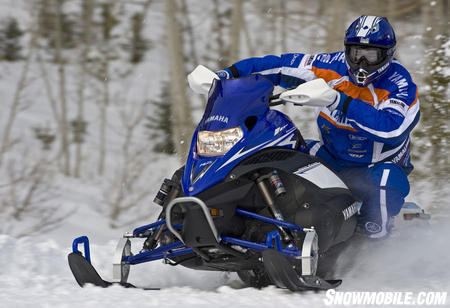
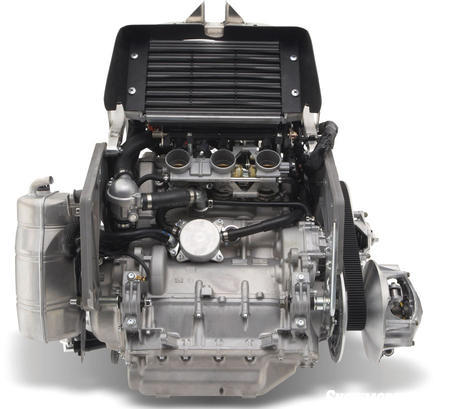
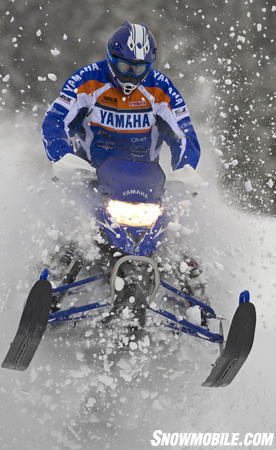
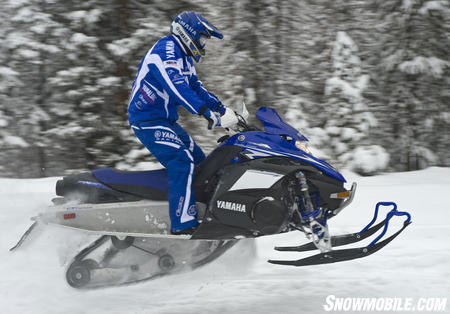
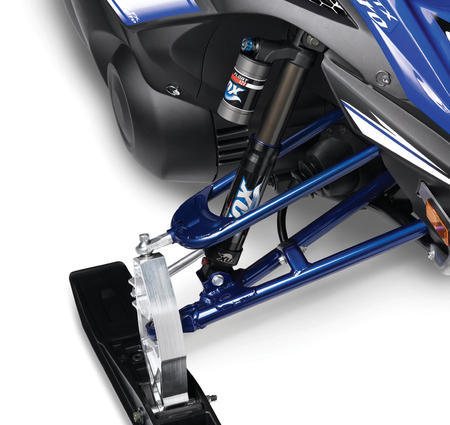





 Your Privacy Choices
Your Privacy Choices